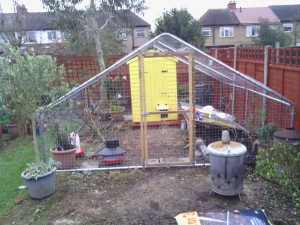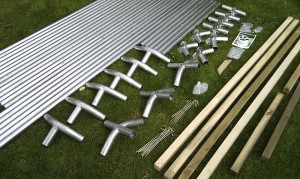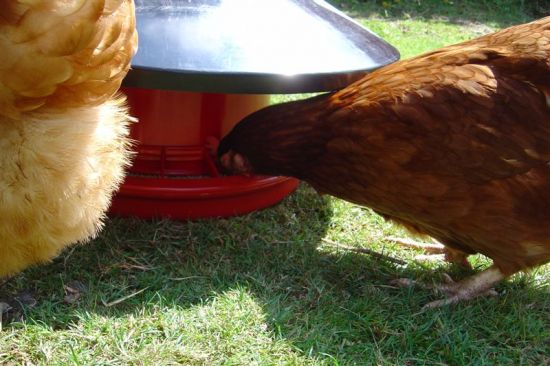 Today, Christmas Eve 2011, the hens moved full-time into the new “winter enclosure”. It is a 4×4 metre enclosure made with steel poles that has weldmesh covering it to keep the hens safe from foxes. Completely inside the enclosure is their new coop, a 4×3 foot shed that stands in the middle of the enclosure, at the back. Continue reading
Today, Christmas Eve 2011, the hens moved full-time into the new “winter enclosure”. It is a 4×4 metre enclosure made with steel poles that has weldmesh covering it to keep the hens safe from foxes. Completely inside the enclosure is their new coop, a 4×3 foot shed that stands in the middle of the enclosure, at the back. Continue reading
Author Archives: Daniel
Timothy watches Juanita in the nestbox
I was finishing off the new coop today – I had just mounted the nestbox in its new position on the back wall of the new coop: Timothy was sitting in the coop with me to keep me company, when Juanita came in to lay her egg.
Timothy was fascinated – he could barely contain his excitement but was VERY good and didn’t jump. He was shivering because it was so cold, but he sat still so that he could keep watching her. I got him his jumper for the second and third videos.
Planning a second enclosure
 After the fox came in broad daylight and killed all of the hens in February, the new hens are locked up in the enclosure all the time – unless we are out in the garden with them. This is clearly less satisfactory than having them completely free in the garden, but for their own safety, is our only option. Continue reading
After the fox came in broad daylight and killed all of the hens in February, the new hens are locked up in the enclosure all the time – unless we are out in the garden with them. This is clearly less satisfactory than having them completely free in the garden, but for their own safety, is our only option. Continue reading
July 2011 new recruits
In July 2011 we went to Thorne’s Poultry Centre in Letchworth and got four new hens. We took these photos on their first day with us.
https://picasaweb.google.com/105379756148606734735/BabyHensJuly2011?authkey=Gv1sRgCOnjnpSy2oaaRQ
The hens are now called Juanita, Tiffany, Blackpie and Whitepie. You can see these photos in our Picasa album.
Why did the chicken cross the road?

Why did the chicken cross the road? It’s an often-asked question!
If you have a possible answer, drop us an email!
Will the eggs hatch into chicks?

No, none of our eggs could ever possibly hatch!
If you know your birds from your bees, you’ll know that to create offspring, you need a boy and a girl to meet up. Our four hens are all girls: they all lay eggs. It’s what they do.
We have no rooster: we don’t want babies and we certainly don’t want the noise that a boy hen would create.
While we have only girls, the eggs cannot have been fertilised, so they can never hatch
GM-free and Organic food for the hens
Allen & Page’s “The Organic Feed Company” make the Layers Pellets which our hens eat as their main food. The feed is recognised by the Soil Association as organic.
The pellets are a farmyard layers feed which produce a deep natural yellow yolk with fantastic taste because it contains no yolk pigmenters which other feeds use. The pellets are drug-free and are ideal for our hens who enjoy living free range because they are designed for non-intensive conditions. Other types of food is available, they are formulated for high performance diets for intensive or commercial production.

What are fresh eggs like?
How many eggs do the hens lay?
One of the first questions people ask when they hear that we keep hens in our back garden is ‘How many eggs do they lay?’
Our hens produce an egg each most days, so that makes four every day – just over two dozen a week. Occasionally there’ll be just three eggs, but that doesn’t happen very often.
We thought that we should be expecting around 200 eggs per year from each hen – so between three and four a week. Perhaps our hens have been specially bred to be even more productive than the typically high productive hens that are used by battery farms. Continue reading
Building the enclosure for the hens
This is a pretty big feat for us, I am a web developer and Annette is a P.A., neither one of us is a handyman, but we now have a big and safe enclosure for our four hens.
This page is here as encouragement to anyone who, like we did in June 2004, is wondering if they would be able to keep hens. You can! We live in Middlesex, just outside London, and even in such a built up metropolitan area, finding and buying supplies isn’t a problem. Continue reading

